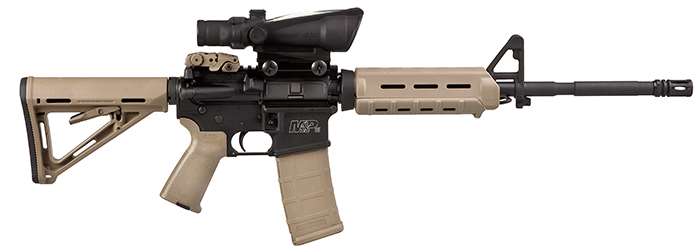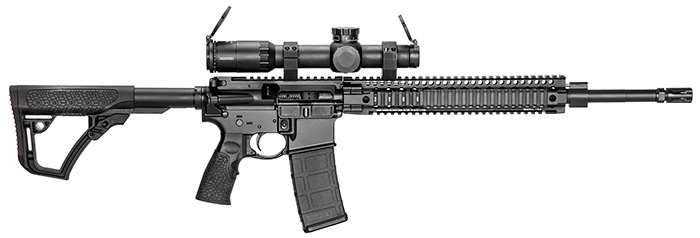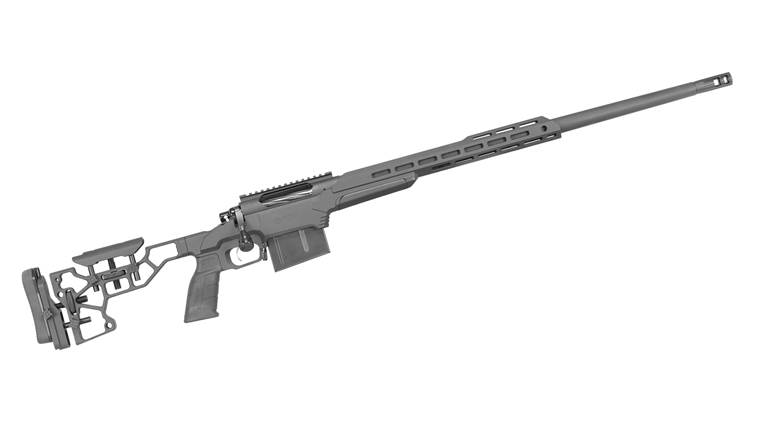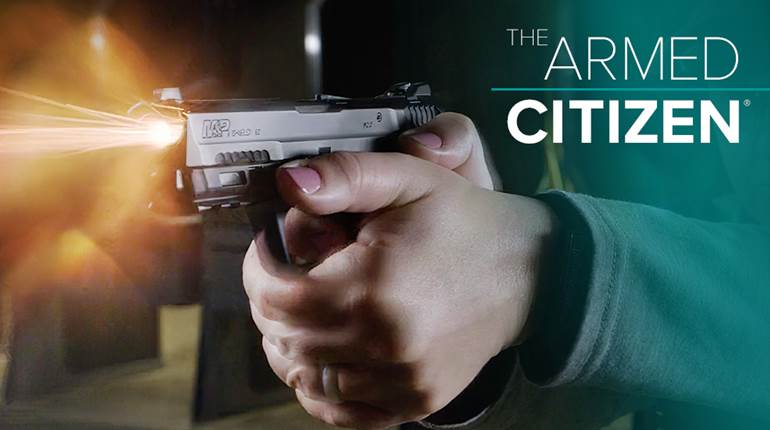
The AR is one of the most versatile rifle systems available today, or at any time in history. It’s true that a few other rifle and/or pistol platforms, such as the Ruger 10/22 and Thompson Center Contender, have been adaptable to a wide range of roles. But historically only a very few specialist models have permitted reconfiguration of the gun from one purpose to another. Versatility, adaptability and modularity are the fundamental characteristics of the AR.
With one “lower,” or complete lower receiver assembly (the serial number is on the lower, thus legally it is the “firearm”), one may affix any number of “uppers,” or complete upper assemblies. These uppers can have different physical characteristics (A1, A2, flattop, high-riser, tri-mount, slick side, forward assist, etc.) as well as different barrel assemblies (lightweight, HBAR, A2, M4, etc.) of differing lengths (from the 16" legal minimum to 24" and more), with different handguards and front sight arrangements, including no front sight at all.
Fewer variations of lowers are extant. In addition to cosmetic variations, there are lower receivers made of lightweight magnesium/aluminum alloy or polymers. Certain lowers may feature an integral trigger guard or various reinforcements. But the real functionality comes from the selection of buttstock, pistol grip, fire control group and so on.
Many of the modifications or accessories one might add to a lower receiver are generally reversible, but those adaptations are more typically optimized for a particular range of purposes. For example, a defensive rifle is not likely to have fitted to it a bulky, four-degree-of-freedom match rifle buttplate, as a varmint or target AR might have. Changing buttplates or buttstocks is quite straightforward, but doing so on a regular basis might prove to become tedious in short order. The same principle applies to extended bolt releases, ambidextrous magazine latches and the like. But, within a broad range of applications, one lower assembly can serve admirably as a basis for a selection of upper assemblies for different uses.
There are many ways to categorize the potential uses of the AR-15. The following taxonomy, I believe, gives as good a basis as any for discussing the appropriate options and accessories one might specify on his or her AR.
Defensive Rifle: Close Quarters
Let’s start with the Short Range Defensive Rifle. While the AR was originally designed as a relatively short-range battle rifle, many think of it first as a Close Quarter Battle (CQB) rifle, particularly in carbine form. As a short-range defensive rifle, the AR has no peer. With proper ammunition, the AR can serve well as a home-defense firearm.
A typical short-range defensive rifle configuration will emphasize compactness. A 16" barrel provides the legal minimum front-end length, while an adjustable stock minimizes the back-end length. The shortest practical overall length is usually considered a good thing in this application, as close quarters imply confined spaces. A collapsible buttstock also helps, adjusting to fit a given rifle to both small- or large-statured shooters.
For quick handling, a lightweight barrel is indicated. However, there are those who feel the need for the rifle’s balance to be farther forward than will result from a lightweight barrel. The shorter the barrel, the more the need for an effective flash suppressor. To allow the mounting of desired sights and ancillaries, free-floating handguards with rails on all four sides are nearly a standard today. Once the barrel configuration has been determined, the sighting systems to be used must be considered. As we are considering a defensive rifle, we must be prepared to use it properly in a wide range of situations. Thus, a degree of redundancy is advised if one chooses to use an optical sight.
Let’s start with iron sights. Factory ARs are now only rarely equipped with A1 sights (adjustable for windage only), A2 sights (adjustable for both windage and elevation) or detachable carry handles with the A2 sight. The standard today appears to be a flat-top upper receiver configuration, with a Swan/Weaver-style or Picatinny rail able to accept a wide variety of rear sights, of both fixed and foldable types, in addition to red-dot sights, holographic sights, telescopic sights, and so on. Most users of this type of rifle will opt for foldable rear and front sights, commonly called Back Up Iron Sights (BUIS) when an optic is used as the primary sighting system.
Some authorities suggest leaving the sights up, selecting and mounting an optic such that the optic can be used while sighting through the iron sights. They assert that if the optic goes down, one will be sufficiently discomfited that flipping up the iron sights may be too readily fumbled under stress. It’s your call.
To avoid excessive occlusion of the field of view, modern thinking is that the iron sights should appear only in the lower third of the optic. This lower-third or “SOCOM” co-witness supersedes the old approach of centering the irons in the optic.
It would seem intuitive that one would want “absolute,” or centered co-witness, putting the red dot on top of the front sight post. But a decade or more of combat experience has taught Special Operations troops that an absolute co-witness can put a potential adversary’s hands out of view behind the front sight post; a lower-third co-witness, where the front sight is well below the centered red dot, allows the viewer to better recognize an opponent’s intentions.
Useful supplements to the CQB rifle’s sighting systems include lights and lasers. High-intensity flashlights provide illumination of a suspected target. These lighting systems are intentionally very bright, so that the person “caught in the headlights” is literally blinded and disoriented. These lights are generally provided with momentary switches so that the user does not become a gratuitous target, but can “flash on” quite briefly to identify a shadow in the darkness.
Many training authorities insist that a defensive rifle is not a “defensive” rifle unless it has an illumination system. Why? The legal system generally frowns on shooting unarmed persons. Check your local laws and justice system predilections.
The handguard arrangement for a short range rifle can be simply the standard-type AR-15 handguards, “railed” handguards that attach in the same manner as the G.I. handguards or one of the various “floating” handguard tubes. As the short range application will require neither tight slinging-up nor bipod use (as a rule), the accuracy advantages of a floating handguard assembly will not apply as emphatically.
But what of the lower receiver assembly? In a short range defensive rifle, the argument can be made that simpler is better. Being able to handle and operate one’s rifle safely and effectively argues against a plethora of gadgets. One option that may prove valuable is a collapsible stock, which permits the user to adjust its length for his individual reach and also makes the gun a bit more compact for stowage.
A bilateral charging handle can make readying the rifle a bit easier and more certain. Unless an extended firefight is anticipated requiring rapid and frequent magazine changes, an extended bolt catch is just one more projection to catch on clothing or brush. Southpaws may want to install a bilateral safety selector and magazine catch, but that’s about it.
The AR is as much a matter of taste as of objectivity; it may be adapted to suit your fancy, fancifully if that’s your preference.
Defensive Rifle: Long Range
The Long Range Defensive Rifle presents a somewhat different set of requirements compared to the short range rifle, while sharing some characteristics. For example, whereas with the short range rifle we might well dispense with optical sights as an unnecessary complication, on a long range rifle a telescopic sight will be needed by most users. A red-dot sight or occluded-eye sight may be preferred by some, but their optimum applications would seem to be at shorter ranges.
While excellent work can be performed with aperture sights, the scope provides an edge for those with aging eyes or the desire for higher perceived precision. More generally, a scope facilitates target identification. When you are off the “square range” with its obvious bullseye, one blob at 600 meters looks much like another. That blob might be a bear or a cow or an innocent bystander. In this case, the flattop receiver provides the best mounting arrangement for a conventional scope. Supplemental iron sights are optional for a sporting application, though for a military shooter they might be a lifesaver if the scope goes down.
Since the optimum in interior ballistics is desired in a long range rifle, a 20" or even 24" barrel would be appropriate. Likewise, a heavier barrel will give more predictable accuracy, particularly after being heated by multiple shots. However, more is not always better; a very heavy match barrel would possibly be more weight than one would care to carry for any distance. If the rifle is intended to be carried on foot for considerable distances, an 18" barrel, possibly fluted to reduce weight while minimally reducing stiffness, might be appreciated. Validation for this approach can be found in the “Mk 12” M16 SOCOM upper of the 2000s, which had a medium-weight 18" barrel. The Mk 12 was intended by the U.S. military to be used for precision shots by a designated marksman. Since long range is the mission, heavy bullets (e.g., 62-gr. and up) are required. The faster twists of 1:9" or 1:7" are needed to stabilize these bullets. The heavier the bullet you choose, the faster the twist you’ll want.
The long range rifle requires a handguard float tube, if only to keep the stress applied by the use of a bipod from changing the point of impact. Because the long range rifle generally does not benefit from a light or laser, a simple round handguard generally suffices. Full-length rails, or even rails on all four sides, are not needed as a rule, but there are exceptions. As for the lower receiver, an adjustable buttstock to properly fit the shooter is generally required.
Many scopes used for long range work have large objective lenses and must be mounted higher than the usual AR sight line. Thus, a stock with provision for a height-adjustable cheekpiece is warranted so that the shooter can maintain a consistent cheekweld. Because a defensive situation might call for the use of several magazines worth of ammunition, features to facilitate quick and sure magazine changes are in order. But, as with the short range rifle, simpler is probably better.
Hunting Rifle: Varmint
The Varmint Rifle may start out looking something like the long range defensive rifle, but its character is quite different. For one, sight redundancy is not only unnecessary, it is superfluous. There will likely be no need to transition to iron sights if the scope goes bad whilst plinking groundhogs at 300 yds. The shooter is more likely to hike back to the pickup for the backup rifle or simply call it a day. A simple gas block with no provision for sight mounting is adequate, and the barrel will be of 20", 24" or even 26" in length, and of heavy contour for rigidity and heat dispersion. A handguard float tube will provide a convenient place to mount a bipod without affecting the barrel and shifting the point of impact. As the ocular of a long-range scope interferes with access to the charging handle, an extended charging handle latch will make bolt cycling trouble-free.
The varmint rifle lower may be more elaborate than those used for defensive rifles. A contoured pistol grip can provide more comfort and control during long periods of searching and sighting. An adjustable buttplate can likewise tailor the rifle’s fit to the user without fear of overcomplication. The varmint—and match rifle, for that matter—application is more tolerant of components and accessories liable to get out of adjustment. Further, there is no danger of hanging up on environmental hazards, such as clothing and car doors. On the whole, failure in this arena is merely embarrassing rather than life-threatening.
Hunting Rifle: Deer-Size Game
In many states, the .223 Rem. cartridge does not meet the caliber or power requirements set forth by state authorities for deer-hunting rifles. However, the AR may be fitted with any one of a number of alternative-caliber uppers, among them 6.5 mm Grendel, 6.8 mm SPC, .300 Blackout, .450 Bushmaster, 7.62x39 mm and others. These cartridges range in power from the equivalent of the .30-30 Win. to a “short .45-70 Gov’t.”
The “big block,” or AR-10-type rifle, is available in calibers from .243 Win. up to pretty much any caliber based on the .308 Win. cartridge case, for which the AR-10 was originally designed. The major difference between the .223 and the alternative-caliber ARs is the barrel, though many alternative calibers will also require a specific bolt, buffer and/or magazine. Thus, my comments regarding the small game rifle will generally apply if deer-size game are the quarry, with the exception of caliber.
Target Rifle: CMP/NRA Service Rifle Competition
The Civilian Marksmanship Program sanctions competitions in cooperation with the NRA for U.S. Service Rifles. Currently accepted rifles for this popular competition include M1, M14, M16 and M110 (AR-10-type). Alas, true M14s and M16s are capable of full-automatic fire, civilian ownership is restricted to the few that were entered into the National Firearms Act (NFA) registry prior to 1986. However, CMP/NRA rules permit the use of “commercial equivalents” to the true U.S. Service Rifles. Thus, the AR qualifies as a service rifle for the purposes of Service Rifle competition.
The gun you use must duplicate the configuration of the M16A2 service rifle. It may not have any external modifications. Thus, backup iron sights are out. Muzzle brakes are out, though “A2” flash hiders (when legal) are in. A plain muzzle is allowed. The barrel must be 20" in length, though twist is optional. Its visible contour, that is, the portion of the barrel in front of the front sight, must be 0.750" or less in diameter. Standard “A2” buttstocks and pistol grips must be used. A two-stage trigger with a pull weight of 4.5 lbs. is specified. A hidden float tube is permitted and necessary as Service Rifle shooters sling up very, very tightly.
Consequently, the CMP/NRA Service Rifle is much like the original NHRA “Super Stock” drag racers: outside, “box-stock.” Inside, blueprinted and massaged right to the ragged edge of the rules. One has little wiggle room for modifications. The secret to a good match rifle is that there are no secrets. Use the best barrel and other components you can find, have it assembled by a meticulous armorer. Then you’ll have a rifle that will shoot well enough to win—if you do your part with proper maintenance and the best ammunition you can make or buy.
Action Shooting/3 Gun/ IPSC Competition
As personalized and idiosyncratic as AR configurations are, this category may stimulate the widest range of variations to suit personal taste. Action shooting is intended to simulate various kinds of action scenarios—some short range, some long range. Speed of target acquisition, rifle handling and rapid accurate fire are critical. This is the arena where extended/bilateral magazine catches, extended bolt releases and bilateral safeties have merit in the eyes of many. Fanciful color schemes have been fashionable, and aesthetic oddities such as octagonal upper receivers (and lowers to match) have been offered to the competing public.
Since the basic rationale of the action gun is that of defensive rifle, most competitors seem to blend characteristics of the short and long range defensive rifles described above, to suit personal taste or the current styling.
Assessing Your Needs
The selection process can best be summarized by reviewing your requirements. For instance, decide whether there are rules or limits that will apply to your configuration’s intended application. Then consider what bullets you want to shoot. There’s also the question of what type of sights you want to use. Of course the gun’s handling characteristics should suit your needs and any ergonomic considerations should be addressed along with whether weight or length is an issue. Finally, determine which accessories you think you might need and make provisions for those. Once you’ve addressed these issues, you should be able to shop for a specific AR that will suit your situation and requirements.
The versatility of the AR may seem bewildering at first; but, if you think through your needs and the best way to fill them, you’ll lessen wasted time, effort and money in acquiring or assembling a configuration that falls short of its intended purpose.












































